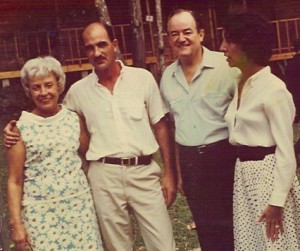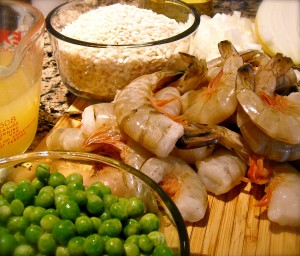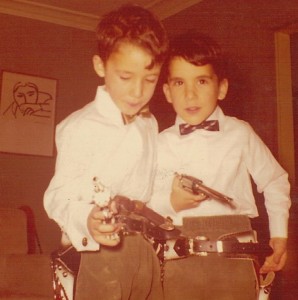Risotto with Shrimp and Peas and Jungle Boy
Risotto is like a woman. It needs a lot of attention. You have to be gentle with it. You’ve got to be patient. You can’t neglect it. Risotto needs love and affection!
My brother was into risotto before anybody else. He’s patient. He has to be — he teaches grade school kids. It’s criminal how much he gets paid. Here’s a guy, works like crazy, spends a lot of his free time helping kids, and they pay him less than the garbage man. No disrespect for garbage men. Some of my best friends are garbage men.
My brother is an incredible athlete, always has been. He played football; he once scored seven touchdowns in one game. He played baseball; he was almost always MVP. He took a lot of his teams to multiple championships. I was on a lot of these teams. I loved playing, but I wasn’t nearly as good as my brother. He had the gift. He was a born athlete.
So when it came time for someone to take a ride on the new horse we had just bought, we all looked to my brother.
The family had just moved to Puerto Rico. My Dad had been asked to help start two new Peace Corps training centers. The centers were a couple miles apart, on top of a mountain in the middle of the rainforest. It was a jungle. Literally. The nearest town was miles away.
The training camps were for volunteers who were going to remote rural areas of Central America. What better place to train them than the jungles of Puerto Rico? The language, the culture, the climate were very similar. So we moved from Rosebank Avenue in Baltimore, Maryland, USA, to the isolated rainforests of Puerto Rico. I was a young teenager.
We were like the Swiss Family Robinson, except we didn’t live in tree houses, but that would have been nicer than the house we had. Our house was made of sheets of plywood, set on top of cinderblocks. There weren’t any windows, just a green plastic screen that stretched around the whole house. The roof was made of corrugated orange plastic.
Outside our door was a long concrete stairway that ran down to the road. And when I say road, I mean a little, narrow, beat-up stretch of old asphalt that ran through the jungle. There were a few other houses for staff and teachers, some bunkhouses for the volunteers, and some classrooms. There was also a comedor—a large cafeteria where everybody ate.
Our small compound was carved out of the middle of the jungle. It rained just about every day, not for long, but really hard. Everything was damp and moldy. Heard of the movie Some Like It Hot? This was Some Like It Moist.
Tarzan and Jane would have been at home there. I think Apocalypse Now was filmed nearby.
Vice President Hubert Humphrey and his wife Muriel visited the camps when we first got there. Guess they needed to check up on my Dad, make sure he was doing a good job with this new Peace Corps thing.
One day our Dad suggested to us kids that we get a horse. My guess is we weren’t going to be plowing fields or herding cattle. My Dad probably wanted to make up for dragging us out of civilization and into the rainforest. Having a horse to ride through the jungle sounded exciting. We borrowed a pickup truck, and drove down the side of the mountain on a tiny stretch of road that was so narrow, everyone approaching honked their horns to warn you they were about to crash into you.
On one side was a wall of rock. And on the other side there was a sheer cliff that fell off for a couple thousand feet, straight into a river called Dos Bocas. The River with Two Mouths.
We drove this old beat-up pickup truck down the side of the mountain, and we ended up in a small village where we bought a small horse. It was a Paso Fino, meaning fine walk in English, which describes the horse’s gait – very smooth.
My Dad named the horse Rocinante, after Don Quixote’s horse.
We somehow got the horse into the back of the pickup truck, and drove back. What a trip. My Dad, us three kids in front, and a horse in the back. We drove up the side of the mountain, honking the horn to make sure we all didn’t die a fiery death rolling off the side of the cliff. That little horse must have been scared to death. I know I was.
We made it back to our house. Miraculously. Rocinante was remarkably calm. We got her out of the truck, no problem. When my Dad asked who’d like to be first to give her a ride, we looked at my brother the athlete.
Only thing was, we had forgotten to get a saddle. So my brother got on the horse bareback. She was very relaxed. For about two seconds. Then Rocinante took off like a rocket. She bolted down the small road, my brother clinging to her neck for dear life.
So much for the Paso Fino. Rocinante’s gait was more like Secretariat breaking out of the starting gate at the Kentucky Derby. They disappeared around a curve. We couldn’t see them through the jungle, but we could hear my brother screaming –“WHOOOAAA!”
My Dad, my sister and I stood in the small road at the bottom of the steps listening as the screams in the jungle got quieter. For a minute, it was dead-quiet.
And then we heard the faint pounding of hooves, getting louder and louder…and suddenly Rocinante appeared, heading straight for us, my brother with his arms around her neck, hanging on for dear life, a look of terror in his eyes.
My dad, my sister and I froze. We should have been leaping into the bushes, but we stood still. That’s when Rocinante took a sharp left turn to avoid us, and she ran all the way up the concrete staircase, with my brother clinging to her neck.
Rocinante made it all the way to the top without killing herself or my brother; then she slowed down. My brother sat up straight, and that’s when a tree branch smacked him right in the puss and knocked him off.
We found out soon after that Rocinante was pregnant. My Dad had bought a pregnant horse.
RISOTTO WITH SHRIMP AND PEAS
I love risotto. The key to risotto is to make sure you stir constantly, slowly, and gently. You will need to monitor the temperature on your stove; you want it warm enough so the broth absorbs, but not so hot that the rice burns. Keep an eye on your risotto!
Keep in mind, cooking times are approximate. I’ve made risotto that was done in 20 minutes, and I’ve made risotto that has taken twice that long. When it tastes done, it’s done.
One of the many great things about this Italian rice? Use the leftovers to make arancini, which are rice balls stuffed with mozzarella cheese.
So always make a lot. Serves 4.
1 quart of chicken stock (you can use vegetable or seafood stock as well)
Saffron, about a dozen threads (it’s expensive but adds such a delightful flavor)
1 pound of shrimp (about 2 cups chopped), de-shelled, de-veined, and chopped into small pieces – save the shells for later!
2 tablespoons extra virgin olive oil
2 tablespoons butter
1 cup chopped onion
1 ½ cups Arborio rice
¼ cup dry white wine
1 cup peas, fresh are best, frozen are fine
Salt and fresh cracked black pepper to taste
Here we go
Put the chicken stock in a saucepan, on medium-low. Take the shrimp shells and put them in the stock – they add a nice flavor. But don’t use them in the risotto — they’re just there to flavor the broth.
I know a gorgeous, smart and lovely gal who hates it when I even suggest putting shrimp shells in the broth. Why?
Who the hell knows? So I leave them out when I cook risotto for her. To All My Manly Man Friends – if you’re cooking, and your Girly-Girl wants you to leave something out, save yourself some trouble and just shut up and do it. Don’t even ask why.
Put the saffron threads in a small bowl. Pour a cup of warm stock over them, and set aside.
Put the olive oil and butter in a large sturdy pot (like a Dutch oven) over medium heat.
When the butter melts, add the cup of chopped onion, and cook for 5 minutes or so, until soft. Stir often.
Add the rice, and stir slowly for about 2 or 3 minutes.
Add the vino, and stir for 2 minutes.
That’s a lot of stirring. Get used to it – risotto is all about the stir.
Turn the heat down to medium-low.
Add a ladle (about 1/2 cup) of warm stock (don’t add the shrimp shells!) and stir slowly and gently until it is absorbed.
Legend has it that the rice will be done 18 minutes from the first ladle of broth.
Mine always seems to take longer, about 24 minutes, but who’s counting?
Make sure your heat is not too high! It needs to be just high enough to let the rice absorb the broth. The heat needs constant monitoring and adjusting.
 Stir your rice. When the bottom of the pan is fairly dry, and most of the broth has been absorbed, add another ladle of warm broth. Stir slowly until the broth is absorbed. It should take about 2 or 3 minutes for the broth to be absorbed. If it takes less time, lower the heat.
Stir your rice. When the bottom of the pan is fairly dry, and most of the broth has been absorbed, add another ladle of warm broth. Stir slowly until the broth is absorbed. It should take about 2 or 3 minutes for the broth to be absorbed. If it takes less time, lower the heat.
Repeat for about 15 minutes – add a ladle of broth, stir slowly and gently until absorbed.
Add the peas.
Then add your shrimp, and some salt and fresh cracked black pepper.
Now add the stock that the saffron has been soaking in (add the saffron, too), stir until absorbed, about 4 or 5 minutes.
Taste the risotto. It needs to be al dente. That means “firm to the bite.” Take a grain of rice, and bite through the middle. If the center appears chalky, it is not done. If it’s not done, add another ladle of broth, and stir slowly until it is absorbed. Check the rice, then take a bite of shrimp. Both the rice and the shrimp should be firm, not tough.
If all goes according to The Slim Plan, when the last ladle of broth is absorbed, the risotto will be done, and the shrimp will be ready, all at the same time. Pronto!
If you run out of stock and the rice is still not done, just add a little water.
Dish it up! Some folks like to grate Parmigiano-Reggiano cheese over top of the risotto. I’m not crazy about combining cheese and seafood.
Except for the fish sandwich at McDonald’s, of course.
MANGIAMO!








Sounds fantastic! Great visual in my mind of your brother on Rocinante. :0)
P.S. You are very smart cookie (pun intended) to listen to your lady! ;0)